Enhancement of Agroecosystem Multifunctionality by Agroforestry: A Global Quantitative Summary
Antoine Mathieu and Marc-Olivier Martin-Guay should be considered joint first authors.
ABSTRACT
In comparison with conventional agriculture, agroforestry systems improve the delivery of multiple ecosystem services and support greater biodiversity. Yet, the effects of agroforestry on various ecosystem services and biodiversity vary worldwide between climatic regions and system types, and studies often focus on measuring a small number of services or biodiversity indicators. We conducted a quantitative summary of multiple large-scale meta-analyses comparing service delivery or biodiversity between agroforestry systems and conventional agricultural systems to capture the global effect of agroforestry on agroecosystem multifunctionality. Data were aggregated from 20 meta-analyses, many of them global, and response ratios were calculated to assess relative effects of agroforestry systems worldwide on multiple categories of biodiversity indicators and production, regulation, and support services. By combining different datasets that addressed specific ecosystem services or biodiversity indicators and analyzing 3075 comparisons between agroforestry systems and their conventional counterparts, we found that agroforestry enhanced ecosystem service delivery and biodiversity globally by an average of 23%. The effects were more pronounced on supporting and regulating services and biodiversity than on production services. The vast majority of analyzed services and biodiversity indicators were enhanced in agroforestry systems, while few were either not affected or affected negatively. Among ecosystem services analyzed along an aridity gradient, only soil organic carbon (SOC) stocks and forage production varied significantly. The positive effects of agroforestry on SOC stocks were stronger in drier conditions, while those on forage production followed a quadratic trend, with maximal benefits in arid conditions. Our results suggest that broad-scale adoption of agroforestry in conventional agriculture could benefit agroecosystem multifunctionality globally without sacrificing productivity and would help support sustainable food production.
1 Introduction
Ecosystem services (ES) have been, and continue to be, a central theme of ecology research for the last two decades. The growing body of work linking ES to human well-being has been compelling (Wang et al. 2021), ever since their relationship was first highlighted in the Millennium Ecosystem Assessment (2005). Yet, the current crisis relating to biodiversity collapse has been linked to a decline in the simultaneous delivery of multiple ES or functions, that is, multifunctionality (Fanin et al. 2017; Hector and Bagchi 2007; Lefcheck et al. 2015). Although the relationship between ES and biodiversity has been debated (Fu et al. 2013), with biodiversity being described both as a regulator of ecosystem processes and as a service in itself (Mace et al. 2012), the ongoing anthropogenic global biodiversity collapse presents a threat to the multifunctionality of ecosystems worldwide (Ceballos and Ehrlich 2023).
Given that the global food system acts as a primary driver of biodiversity and ES loss (Foley et al. 2005; Newbold et al. 2015), it is becoming increasingly clear that feeding humanity in the future while minimizing effects on agroecosystems will represent a challenge (FAO 2022; HLPE 2020). These major intertwined problems force us to consider multifaceted and integrated solutions, such as the transition from conventional agriculture towards using more sustainable agroecological practices such as agroforestry (Ewert et al. 2023; Wezel et al. 2014). Agroforestry has been identified by the Intergovernmental Panel on Climate Change (IPCC) as a key measure, both for adapting the global food system to climate change and for mitigating its impacts (Shukla et al. 2019). This practice is defined as a wide set of systems that are based on the integration of trees or shrubs into croplands or pastures. It has been a subject of research since the early 20th C. (Kort 1988) when treed shelterbelts and windbreaks were studied as a solution for ensuring protection of temperate crops from the effects of wind.
Following a recent shift in agronomic sciences from a “productivist” perspective (Tilzey 2000) to a more environmentally holistic approach that is focused upon soil health, biochemistry, microbiological activity, and greenhouse gas (GHG) emissions (Sellami and Terribile 2023), agroforestry research has seen an emergence of similar trends. Carbon sequestration, ES, and biodiversity have become its central themes in recent years, highlighting the multifunctional potential of agroforestry systems (Liu et al. 2019). On one hand, when compared to conventional agricultural systems, multiple studies have shown that agroforestry systems (AFS) can promote biodiversity and multifunctionality while mitigating climate change through carbon (C) sequestration (Jose and Udawatta 2021; Nair et al. 2021a, 2021b; Torralba et al. 2016). On the other hand, studies have also reported adverse effects of agroforestry on biodiversity and ES (Bohada-Murillo et al. 2020; Torralba et al. 2016), demonstrating that more research on AFS is needed, given that the discipline is still in its early stages (Boinot et al. 2022).
Carbon sequestration has been a specific central theme in agroforestry research over the past decade (Liu et al. 2019). Meta-analyses report higher biomass C stocks and higher C sequestration rates for both soils and biomass in AFS versus croplands and pastures/grasslands (Kim et al. 2016; Ma et al. 2020; Mayer et al. 2022). Some have also reported higher soil organic carbon (SOC) stocks or total soil carbon in AFS than in croplands, and higher or equivalent SOC stocks than in pastures/grasslands (Chatterjee et al. 2018; De Stefano and Jacobson 2018; Drexler et al. 2021; Félix et al. 2018; Ma et al. 2020). Differences in SOC stocks, biomass C, and C sequestration rates were encountered that depended upon AFS type and climatic zones (Chatterjee et al. 2018; Feliciano et al. 2018; Kim et al. 2016; Ma et al. 2020; Mayer et al. 2022).
Several meta-analyses also assessed AFS effects on other ES such as provisioning (or production) services. Work focusing upon such ES, for example, agricultural yields, is relatively abundant, mainly because these services are primary drivers of agricultural production. Higher crop yields were reported for some AFS versus their conventional monoculture counterparts (Félix et al. 2018; Kort 1988; Kuyah et al. 2019), while the positive influence of trees on grass productivity increases in more arid environments (Dohn et al. 2013; Mazía et al. 2016). The effects of trees on pasture production in silvopastoral systems are more nuanced; one meta-analysis reported positive effects in temperate climates (Pent 2020), while another that was conducted at the global scale showed a neutral effect (Rivest et al. 2013).
Studies have also focused on the effects of AFS on regulating or supporting ES, often reporting benefits. Water regulation services, in particular, have often been assessed in such studies, highlighting the ability of AFS to reduce runoff (Kuyah et al. 2019) while retaining nitrogen (Valkama et al. 2019), together with enhancing soil moisture properties such as retention capacity, moisture content, and infiltration rates (Basche and DeLonge 2017; Ilstedt et al. 2007; Kuyah et al. 2019).
ES delivery is sometimes analyzed as a whole, as was in the case of De Beenhouwer et al. (2013), where the authors reported better ES delivery in AFS versus cocoa or coffee plantations, together with positive effects of AFS on biodiversity (i.e., species richness). Yet, another meta-analysis showed that the presence of trees is beneficial to biodiversity, both in terms of abundance and species richness (Prevedello et al. 2018). Conversely, other research has demonstrated that AFS has no clear effects on biodiversity (Mupepele et al. 2021).
Having appeared for different needs in different biological and climatic contexts, agroforestry varies widely in its application between temperate and tropical climates. While hedgerows, shelterbelts, riparian buffer strips, and silvopastoral systems are frequently observed in temperate industrialized agriculture settings, cocoa or coffee agroforests are often found in tropical South America, Africa, and Asia. Agroforestry parklands mimicking open savannah are most popular in semi-arid West Africa (Boffa 1999), while homegardens and alley cropping are common in sub-Saharan Africa (Kuyah et al. 2019). Given that different practices are conducted between regions depending upon climate, soils, and landscapes, research trends on temperate and tropical agroforestry vary widely (Liu et al. 2019). As such, because agroforestry can be adapted to highly diverse systems and contexts, studies focused on assessing the effects of AFS on specific elements have limited their scope to relevant scenarios.
Moreover, previous work has suggested a differential impact of AFS on specific ES or processes depending on climate, namely ES related to water regulation and grass productivity (Basche and DeLonge 2017; Dohn et al. 2013), suggesting that AFS might be more beneficial in drier climates than in more humid climates. Given the accelerating problem of desertification (Huang et al. 2016), it is critical to assess the effects of AFS on ES and biodiversity along an aridity gradient (Figure 1) to determine whether agroforestry could serve as a potential solution to mitigate desertification impacts on agroecosystems.
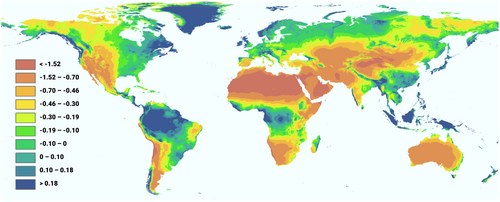
Because agroforestry principles can take form in many different ways (i.e., differences in system type, objectives, species that are used, etc.), it is difficult to generalize how they affect agroecosystems. As such, to our knowledge, no study has yet focused upon characterizing the general effect of agroforestry on biodiversity and ecosystem multifunctionality at a global scale. Thus far, a multitude of studies that are relevant to the assessment of AFS multifunctionality have been published, but they were conducted within a limited scope. Such studies have often focused solely on: (1) a limited number of ES or functions (e.g., C sequestration and agricultural production), (2) biodiversity, (3) a specific type of agroforestry system (e.g., cocoa-coffee agroforestry and alley cropping), or (4) a specific bioregion or biome.
Here, we address these limitations by presenting a global quantitative summary of the effects of AFS on biodiversity and ES or function delivery. In this integrative meta-analysis, we synthesize data originating from previous meta-analyses comparing AFS to agricultural controls to try and capture broad-scale effects of AFS adoption in agroecosystems worldwide across a global aridity gradient. By aggregating a multitude of data on specific ES or biodiversity indicators across multiple AFS types worldwide, this study aims to (1) quantify how the addition of trees modifies agroecosystem multifunctionality, (2) assess potential trade-offs between the delivery of different ES, and (3) evaluate the global variability of ES delivery in AFS along an aridity index gradient.
Although there are many ways in which agroecosystems can be modified to mitigate climate change and enhance ES delivery (Drever et al. 2021), focusing exclusively on cases where trees or shrubs were added to agroecosystems enables us to assess their effects on multifunctionality through mechanisms that are related to their structure and interactions with the environment. Thus, we did not consider cases where agricultural diversification involved herbaceous plants, for example, through the addition of herbaceous crops in vineyards.
The global area under AFS is estimated at 1.6 billion hectares, with about 78% located in tropical regions and 22% in temperate regions (Nair et al. 2021c). This area represents approximately one-third of the total land surface that is used for agriculture (croplands and pasture lands) worldwide. Almost 57% of global croplands have less than 10% tree cover (Zomer et al. 2016). Accordingly, the widespread adoption of AFS remains limited in many regions across the globe. The present study is important and novel, given that it offers for the first time a global assessment of multiple ecosystem services and effects on biodiversity provided by AFS. Addressing this knowledge gap could offer scientifically vetted support to enhance policy frameworks, encouraging greater adoption of AFS by farmers (Thiesmeier and Zander 2023; Tranchina et al. 2024).
2 Materials and Methods
2.1 Data Collection and Selection
We selected peer-reviewed meta-analyses on AFS effects on ES through a systematic search using Scopus, ISI Web of Science, and Google Scholar. In November 2021, we searched titles, abstracts, and keywords based on the following combination of search terms: (Meta-analysis OR Review) AND (Agroforestry OR Silvorarable OR Alley cropping OR Tree-based intercropping OR Hedgerows OR Windbreaks OR Shelterbelts OR Living fences OR Silvopastoral OR Silvopasture OR Scattered trees OR Parklands OR Homegardens OR Multistrata agroforests OR Shadow systems) AND (Ecosystem services OR Biodiversity OR Carbon OR Water OR Soil OR Yield OR Production). Only publications satisfying the following criteria were retained for the analysis: (1) the publication reported a meta-analysis of quantitative results that was based on several primary studies conducted on field experiments; (2) the meta-analysis focused on at least one AFS that was listed in the search terms; (3) the meta-analysis included comparisons between agroforestry and agricultural control plots; and (4) the meta-analysis provided a complete database or data that were made available to us through personal communication.
Collected databases were screened using certain selection criteria in order to answer our general questions appropriately. We excluded occurrences where AFS were compared to agricultural controls in which the agricultural activity differed (e.g., silvopastures or cocoa-based agroforestry compared to annual crops), where the effects of compared variables on known ES could not be clearly classified as beneficial or detrimental (e.g., effects on specific root length or root diameter), and where the diversification of the agroecosystem was not performed with woody species, for example, orchards intercropped with grass as shown in Morugán-Coronado et al. (2020). We also excluded AFS that were compared to forest ecosystems, since we were mainly interested in what trees can bring to agroecosystems.
After applying the selection criteria, 20 meta-analysis databases were included totally or partially (Table 1). Thorough verification and screening of every primary source's DOI were performed to identify duplicates, and a total of 3075 unique comparisons between an AFS and its equivalent agricultural control were compiled (Figures 2 and 3). Each comparison was then associated with the related category (biodiversity, provisioning ES, or regulating/supporting ES), depending upon the variable being compared (see Table S1 for the detailed categorization). Individual AFS types were categorized into broader categories (Table 2).
| Reference | Region | Types of agroforestry systems included (as referenced by authors) | Category: subcategory of studied variables | Inclusion of database | Number of included comparisons |
|---|---|---|---|---|---|
| Basche and DeLonge 2017 | Global | Alley cropping | Regulating/supporting: water regulation | Partial | 1 |
| Chatterjee et al. 2018 | Global | Agrisilviculture, multistrata systems, silvoarable, silvopasture | Regulating/supporting: SOC stocks | Partial | 580 |
| De Beenhouwer et al. 2013 | Tropical | Cocoa- and coffee-based agroforestry |
Biodiversity: diversity invertebrates, diversity plants, diversity vertebrates; Provisioning: Crop production, medicinal plants*, wood production*; Regulating/supporting: above-ground C, pest control*, pollination*, root C stocks*, SOC stocks, soil fertility, water regulation |
Total | 98 |
| De Stefano and Jacobson 2018 | Global | Agrisilviculture, silvopasture | Regulating/supporting: SOC stocks | Partial | 103 |
| Dohn et al. 2013 | Global | Silvopasture |
Provisioning: forage production; Regulating/supporting: soil fertility |
Total | 185 |
| Drexler et al. 2021 | Temperate | Hedgerows | Regulating/supporting: SOC stocks | Partial | 16 |
| Feliciano et al. 2018 | Global | Homegarden, improved fallows, intercropping, woodlots, parklands, silvopastures, fast-growing trees, agrisilvicultural, alley cropping, coffee-based agroforestry, live fence | Regulating/supporting: above-ground C, SOC sequestration | Partial | 75 |
| Félix et al. 2018 | Semi-arid West Africa | Parklands with crops | Regulating/supporting: SOC stocks, soil fertility, water regulation | Partial | 387 |
| Ilstedt et al. 2007 | Tropical | Agrisilviculture | Regulating/supporting: water regulation | Partial | 6 |
| Kim et al. 2016 | Global | Improved fallows, shaded perennial-crop systems, intercropping systems, tree plantations on arable lands, riparian buffer, shelterbelt | Regulating/supporting: GHG emissions, SOC stocks, soil fertility | Partial | 93 |
| Kort 1988 | Global | Shelterbelts | Provisioning: crop production, forage production | Total | 97 |
| Kuyah et al. 2019 | Sub-Saharan Africa | Under canopy, planted fallow, alley cropping, intercrop, hedgerow, multistrata, windbreaks, boundary planting |
Provisioning: crop production; Regulating/supporting: SOC stocks, soil fertility, water regulation |
Partial | 887 |
| Ma et al. 2020 | Global | Silvoarable, silvopasture | Regulating/supporting: SOC stocks | Partial | 303 |
| Mayer et al. 2022 | Temperate | Hedgerows, alley cropping, silvopasture | Regulating/supporting: SOC stocks | Partial | 87 |
| Mazía et al. 2016 | Global | Silvopasture | Provisioning: forage production | Partial | 93 |
| Mupepele et al. 2021 | Europe | Silvoarable, silvopasture | Biodiversity: diversity invertebrates, diversity plants, diversity vertebrates | Partial | 44 |
| Pent 2020 | Temperate | Silvopasture | Provisioning: forage production (whole field), livestock production (whole field) | Total | 62 |
| Prevedello et al. 2018 | Global | Scattered trees | Biodiversity: abundance invertebrates, abundance plants, abundance vertebrates, diversity invertebrates, diversity plants, diversity vertebrates | Partial | 391 |
| Rivest et al. 2013 | Global | Scattered trees, Silvopasture | Provisioning: forage production | Total | 73 |
| Valkama et al. 2019 | Global | Riparian buffer | Regulating/supporting: water regulation | Partial | 38 |
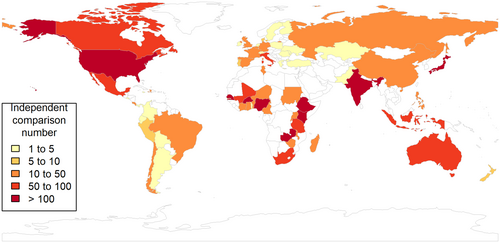
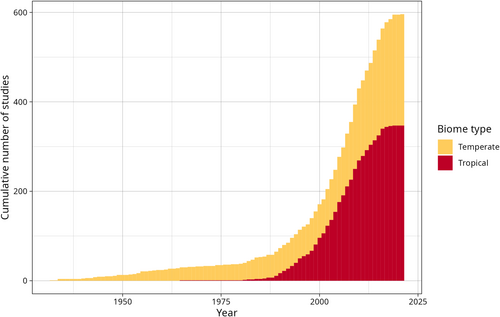
| AFS category | AFS type |
|---|---|
| Boundary planting | Hedgerow |
| Live fence | |
| Riparian buffer | |
| Shelterbelt | |
| Undefined boundary planting | |
| Windbreaks | |
| Complex | Forest garden |
| Multistrata | |
| Perennial-based agroforestry | Cocoa-based agroforestry |
| Coffee-based agroforestry | |
| Tea-based agroforestry | |
| Undefined perennial-based agroforestry | |
| Rotation agroforestry | Improved fallow |
| Rotational woodlot | |
| Slash-and-burn system | |
| Silvoarable | Alley cropping |
| Parklands with crops | |
| Undefined silvoarable | |
| Silvopasture | Parklands |
| Scattered trees | |
| Undefined silvopasture |
Regulating and supporting ES were pooled in a single category because some analyzed ecosystem functions could relate to multiple services that were found in either category. For example, C sequestration plays a role in climate regulation (regulation ES) and in soil nutrient cycles (support ES).
Certain comparisons that were contained in primary sources did not specifically target AFS, but were treated as such in our analysis. For example, a study comparing grassland productivity in the presence or absence of trees is of interest, even if said grasslands were not being used in an agricultural context (i.e., grazed or exploited for forage production). Comparisons between AFS and forest ecosystems were not included in our database because we believe that they imply a more complex analysis of agroforestry effects at the landscape scale. Moreover, we focused on showing the potential of AFS in modifying already existing agricultural systems, rather than the effects of altering natural ecosystems by establishing AFS.
We extracted the Global Aridity index (Global-AI; see Figure 1) for the geolocated data from the online database, which was made available by the Consortium for Spatial Information (Zomer et al. 2022). This index is obtained by dividing mean annual precipitation by mean annual reference evapotranspiration. The ratio increases with precipitation availability over atmospheric water demand, leading to larger values in more humid conditions.
2.2 Statistical Analyses
This was possible because all reported data used the same metrics for both AFS and the control, including biodiversity indicators.
We tested whether the average effect size differed from zero for each category of services or each type of AFS, when they contained at least ten independent comparisons (in terms of adjusted N, i.e., ten unique comparisons). The same model and bootstrapping procedure were used to obtain the 95% confidence intervals.
3 Results
While early agroforestry research focused extensively on temperate biomes, tropical agroforestry research has become much more abundant since the 1990s and now comprises the majority of recent work, reflecting an ongoing global surge in the popularity of agroforestry research (Figure 3).
3.1 General Effects
The overall effect size of AFS on ES delivery and biodiversity was significantly positive, with a 23% increase when compared to their respective agricultural controls (Figure 4a). Every biodiversity indicator and subcategory of ES that was included in the analysis reached either higher or equivalent levels in AFS compared to conventional agricultural settings, except for forage and livestock production services in whole field settings. In these cases, the surface that was lost to trees was explicitly included in the area for which silvopasture productivity was evaluated (Figure 5; see Discussion). Biodiversity indicators, together with regulating and supporting services, showed greater improvement in AFS than did provisioning services. Although positive overall, the frequency distribution of the effects of AFS on reported comparisons showed great variability (Figure 4a). There were 2126 of 3075 reported comparisons (69%) for which AFS effects were positive, while 859 (28%) had negative effects (the remaining 3% were neutral; adjusted N accounting for duplication among meta-analyses).
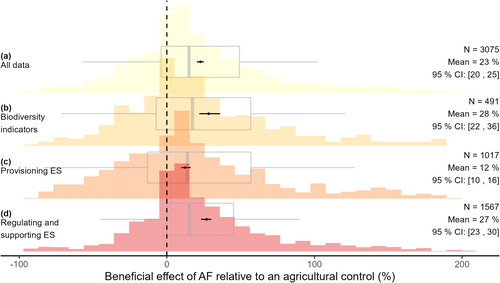
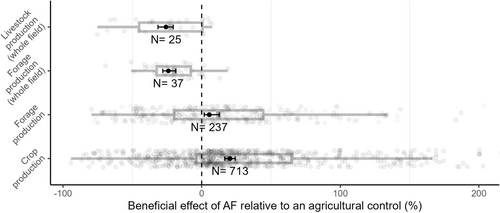
3.2 Provisioning Ecosystem Services
Both forage and crop production were enhanced in AFS when compared to conventional agricultural controls (Figure 5). Crop production showed the greatest enhancement in AFS, with an average increase of 20.4%, followed by forage production, which increased by 5.5% on average. In contrast, whole field forage and livestock production were both reduced in AFS, with the former decreasing by 24% and the latter by 25.8%. It is important to note that the surface area that was lost to trees was explicitly included when evaluating whole field productivity variables (see Discussion).
AFS exerted beneficial or neutral effects on productivity for all crops that were included in the analysis (Figure S1). Maize and wheat, the two most prevalent crops in our database, increased their production within AFS by 22.8% and 26%, respectively (Figure S1). Other crops, such as oats, millet, groundnut, cowpea, and barley, also experienced productivity enhancements, ranging from an average of 13.3% for oats to 108.5% for groundnut. Neither sorghum nor cassava productivity was affected by agroforestry.
3.3 Regulating and Supporting Ecosystem Services
Results showed beneficial or neutral effects of AFS on regulating and supporting services (Figure 6), depending upon the subcategory. On average, soil fertility, water regulation, and SOC stocks and sequestration were all improved in AFS (for the latter, 95% CIs are just above zero). Average improvements ranged from 10.4% for SOC sequestration to 56% for water regulation services. Yet, the effects of agroforestry on GHG emissions were neutral, as the 95% CI includes 0. Methane (CH4) and nitrous oxide (N2O) were the only two GHGs included in the dataset. Aboveground C (stocks or sequestration) was greatly enhanced in AFS.
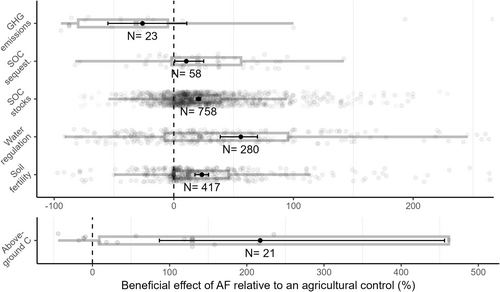
All soil fertility services responded either positively or neutrally to the presence of trees (Figure S2). The two most represented variables in our data, soil content or availability of P and N, were improved on average by 16.8% and 21.5%, respectively. Soil content or availability of N is consistent with the benefits for leaf N content, which improved by 50.8%. Effects of AFS on soil content or availability of P were neutral, as its 95% CI included 0. Beneficial effects of agroforestry on soil loss and bulk density mean that both variables were reduced on average (see “Statistical analyses” in the “Methods” section). Moreover, all water regulation services were enhanced in AFS (ranging from 46.6% enhancement for infiltration to 293.5% for groundwater nitrate leaching), except for soil moisture and rainfall use efficiency, which were unaffected (Figure S3). Benefits regarding water runoff and groundwater nitrate leaching mean reduced levels of these two variables (see “Statistical analyses” in the “Methods” section).
3.4 Biodiversity
On average, biodiversity and abundance for all major taxa in the analysis were improved in AFS, with benefits ranging from 13.9% for abundance of plants to 55.5% for diversity of vertebrates (Figure 7).
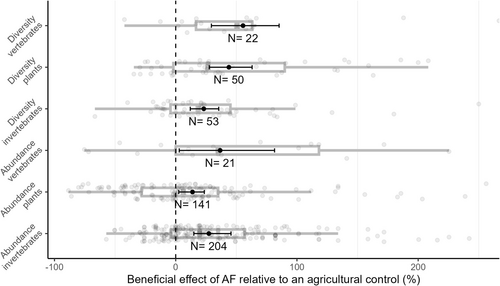
3.5 Comparing Effect Sizes Among Agroforestry System Types
The sum of effects on all measured ES and biodiversity indicators was positive for all categories of AFS (Figure 8, Table 2). Effect size varied among categories, with silvopastures and silvoarable AFS appearing to bring weaker effects on ES delivery and biodiversity than others. Average benefits of silvopastures and silvoarable AFS were 10.1% and 16.4%, respectively, while other system categories averaged between 43.8% and 46% enhancement. All individual system types presented benefits, except undefined perennial-based agroforestry, which had neutral effects on ES delivery (Figure S4).
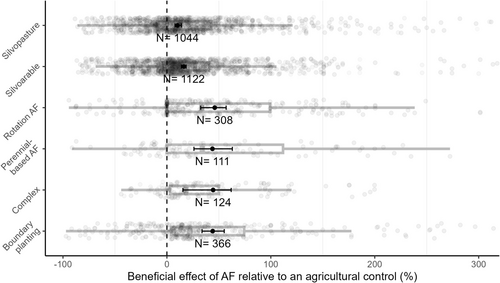
3.6 Aridity Index
Of the five ES subcategories for which we analyzed the effects of AFS along the Global-AI aridity index scale, only SOC stocks and forage production in AFS were affected by aridity (Figure 9). The positive effects of AFS on SOC stocks were stronger in drier conditions (low index values; see Figure 1). Forage production exhibited a more complex quadratic relationship with the aridity index, being differentially enhanced in drier conditions while decreasing in more humid conditions. AFS effects were neutral in hyper-arid conditions, maximal and positive in arid conditions, and then trended towards being neutral and negative as humidity increased.
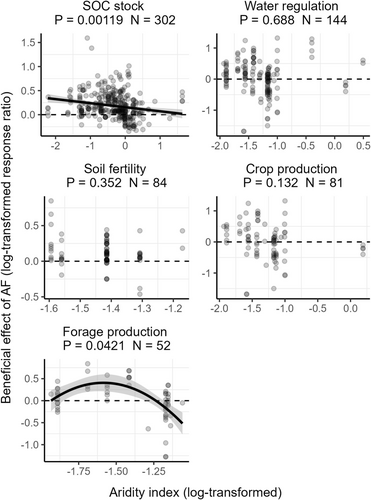
4 Discussion
4.1 General Effects
For the first time, by combining different datasets that each addressed specific ES or biodiversity indicators in AFS worldwide, we can better analyze AFS multifunctionality as a whole. Further, we show that a shift from conventional agriculture to agroforestry can enhance the global resiliency and multifunctionality of agroecosystems without compromising agricultural production, regulation, and support services, or biodiversity. Similar results have been found in the tropics when comparing AFS to coffee or cocoa plantations (De Beenhouwer et al. 2013). Conversely, Torralba et al. (2016) reported no significant enhancement of ES and biodiversity in European AFS compared to agricultural or pasture land. However, their study analyzed only 109 comparisons between AFS and conventional agriculture, while our results are based on 3075 comparisons.
Enhancement of agroecosystem biodiversity and ES delivery in AFS is likely linked to the fact that they can provide more complex habitats than conventional farming systems and host both forest and agricultural species (Bhagwat et al. 2008). Establishment of AFS into agroecosystems contributes to the ecological restoration of lands that have been degraded by agricultural activities (Shimamoto et al. 2018). Yet, ecological restoration of lands has been shown to enhance both ES delivery and biodiversity (Crouzeilles et al. 2017; Ren et al. 2017; Shimamoto et al. 2018). In agroecosystems specifically, a global meta-analysis showed a substantial increase in biodiversity and ES delivery after restoration actions had been set in place (Barral et al. 2015). Rey Benayas et al. (2009) found a stronger effect of ecological restoration on the delivery of supporting services than on regulating services, yet no effect on provisioning services.
4.2 Provisioning Ecosystem Services
Both forage and crop production are enhanced in AFS when compared to conventional agricultural controls (Figure 5). This result is supported by studies assessing yield responses of multiple crops that are protected by windbreaks in the United States (see Smith et al. 2021 and references therein), as well as research on AFS coffee production in the tropics (Koutouleas et al. 2022; Piato et al. 2020).
Data comprising whole field provisioning variables (Figure 5), which are both reduced in AFS, all originate from a single study (Pent 2020), where the author evaluated over-yielding in silvopastures only. The surface that was lost to trees was explicitly included in the area that was considered when evaluating these whole field productivity variables. Tree production in these whole field settings (where the surface that was lost to forage or livestock production was included) was about 30% lower than in forests or timber plantations. However, the total combined productivity of both trees and forage/livestock was higher than the production of each component in their respective controls (Pent 2020). While both whole field forage and livestock production were reduced at the scale of the entire production area in silvopastures relative to treeless pastures, Pent (2020) reported a general increase of 42–55% in overall productivity (over-yielding) in silvopastures. Similar values were reported for timber production in silvopastures relative to forests, timber plantations, and orchards. Silvopastures were thus generally more productive per unit surface area for the production of forage, livestock, and wood when compared to either pastures, forests, timber plantations, or orchards that were managed separately (Pent 2020).
In other cases, that is, where productivity was not reported as whole field values, the data we collated usually did not specify whether yields in the AFS included the area that was lost to trees. However, agroforestry literature almost universally bases yield calculations on the cultivated area, for example, by measuring biomass in a 1 m2 quadrat near a scattered tree and comparing it to that of another 1 m2 quadrat outside its vicinity. We note that the crop and forage production subcategories include data from four and five meta-analyses, respectively.
AFS exerted beneficial or neutral effects on productivity for all crops that were included in the analysis (Figure S1). This is consistent with the findings of a global meta-analysis where a 7% increase in maize yields was reported in AFS versus conventional agriculture (Baier et al. 2023), and with reports on multiple crops contained in Smith et al. (2021). Maize was by far the most frequently represented crop in our dataset, accounting for 61.9% of all comparisons. Grains represent crops of unspecified species (Figure S1). Most data in the provisioning services category (around 55.4%) originate from a single study assessing ES delivery in AFS that are located in sub-Saharan Africa (Kuyah et al. 2019). Meta-analyses seem to be lacking quality data for comparing crops and forage yields in AFS versus conventional agriculture in other parts of the world, which is surprising considering their central importance to agroforestry research from a purely pragmatic standpoint. Therefore, future work should focus on curating quality data for comparing crop productivity in AFS versus conventional agricultural settings.
Wood production, which is a provisioning ES, was not included in the subcategories analysis (Figure 5), because less than ten comparisons were available between AFS and conventional agriculture, as wood production is often completely absent from the latter. However, wood production data were included in the global Provisioning ES category analysis (Figure 4c). Yet, wood production values are essential when assessing the land-equivalent ratio (LER) of AFS, as was demonstrated by Pent (2020), and should not be discounted when analyzing AFS productivity. Smallholder and low-income farmers especially can benefit from wood production as a source of timber and fuelwood, and as a means of increasing income through economic opportunities (Scherr 2004).
While ecological restoration of ecosystems enhances their general ability to deliver ES (Crouzeilles et al. 2017; Ren et al. 2017; Rey Benayas et al. 2009; Shimamoto et al. 2018), its effects on provisioning services at play in agriculture appear to be scale-dependent. At a regional scale, afforestation of degraded land can counteract problems such as soil erosion and diminution of water yield, while in turn enhancing provisioning services (Liu et al. 2019; Su and Fu 2013). Yet, enhancement of provisioning services (i.e., productivity) in AFS is often attributed to smaller scale, local mechanisms. Trees and shrubs can benefit crop and forage production by enhancing soil fertility (Guo et al. 2018; Gusli et al. 2020; Peichl et al. 2006), by modifying the microclimate (Brandle et al. 2004; Kort 1988; Koutouleas et al. 2022; Piato et al. 2020; Rao et al. 2007), by modifying soil physical properties (Gusli et al. 2020; Suárez et al. 2021; Udawatta et al. 2017), and by improving moisture availability (Bayala and Prieto 2020; Gusli et al. 2020; Jiang et al. 2019).
4.3 Regulating and Supporting Ecosystem Services
Soil SOC stocks and fertility, as well as water regulation services were by far the most frequently reported services in the regulating and supporting category (Figure 6). The distribution of individual ES forming soil fertility (Figure S2) and water regulation (Figure S3) subcategories was unbalanced, given that some ES were reported more frequently than others and contributed strongly to the average effect within their respective ES subcategories. As such, rainfall use efficiency accounted for more than half (53.4%) of all comparisons under the water regulation subcategory (Figure S3), whereas soil phosphorus (P) and nitrogen (N) content accounted for a combined 62.4% of all comparisons in the soil fertility subcategory (Figure S2). The importance of soil N and P for plant fertilization in agricultural settings could explain their prevalence in the dataset. Surprisingly, not a single study in our dataset compared soil potassium (K) availability or content in AFS versus conventional agricultural settings. Soil SOC stocks, for which data were collated from nine meta-analyses, accounted for about a quarter (24.6%) of every unique comparison that was extracted from primary sources, for all categories. Thus, they were analyzed independently of other soil fertility indicators due to their disproportionate representation in the database. In contrast, ES relating to climate change mitigation other than SOC stocks (i.e., SOC sequestration and GHG emissions) have been surprisingly poorly represented in the data. We excluded numerous data that were related to C stocks and sequestration within tree biomass because they lacked control values that allowed the calculation of effect sizes. This explains why aboveground C data are so limited (Figure 6).
Our analysis revealed a beneficial effect of agroforestry on soil fertility services on average (Figure 6). These results align with generally reported effects of AFS on soil properties in diverse environments (see Rolo et al. 2023). For instance, soil nutrient enrichment in AFS has been observed in both temperate and tropical climates and is reported to be mainly driven by additional plant litter (Muchane et al. 2020; Rolo et al. 2012; Sileshi et al. 2014). Soil loss reduction in AFS is mainly attributable to runoff and wind speed reduction (Chang et al. 2021; Řeháček et al. 2017; Zhu et al. 2020). Tree roots in AFS can modify soil structure by promoting aggregate formation, which favors a lower bulk density (Suárez et al. 2021; Udawatta et al. 2017). The neutral effects of AFS on C/N ratio that were observed in our results could simply be explained by the simultaneous rise of soil C and N contents, resulting in no observable change in the ratio.
Water regulation services in AFS (Figure S3) refer to local water management (cf. Félix et al. 2018) and to landscape-scale water protection services such as groundwater nutrient leaching and runoff control (cf. Valkama et al. 2019). AFS have been shown to reduce flooding risks (Singh and Lal 2018) and to enhance local soil hydrological processes and water management through various means that are mainly driven by tree roots, namely, accumulation of soil organic matter and formation of stable soil aggregates (Janzen et al. 2024; Rolo et al. 2023 and references therein). All rainfall use efficiency data come from a single meta-analysis focusing on semi-arid West Africa that was reported by Félix et al. (2018). As such, water regulation ES data are disproportionately driven by data originating from a single region.
Because of their important role in both climate change mitigation and soil fertility, soil SOC stocks have been studied extensively in AFS, where more SOC is stored under and near trees than in conventional agricultural systems. This is due in part to the massive importation of litter from trees and tree-soil interactions. As such, some meta-analyses have focused on SOC stocks as a component of soil fertility (e.g., Kuyah et al. 2019), while others analyzed them as part of the carbon-sink potential of AFS (e.g., Chatterjee et al. 2018). Data pertaining to SOC sequestration rates, however, are less frequently presented in the literature than data on SOC stocks. This can be partly explained by the fact that rates are more challenging to measure, as a temporal component must be accounted for, contrary to stocks, which can be measured at a single point in time.
Emissions of GHGs (CH4 and N2O) on average were not affected by AFS. Conversely, Gross et al. (2022) reported augmented CH4 uptake and reduced N2O emissions under perennial vegetation in AFS versus adjacent fields in the Canadian Prairies. Yet, all GHG emission data originate from a single meta-analysis citing mostly primary studies that were conducted in a tropical climate (Kim et al. 2016). Therefore, differences in the dynamics of CH4 and N2O emissions between temperate and tropical AFS should be addressed in future work.
4.4 Biodiversity
On average, biodiversity and abundance for all major taxa in the analysis were improved in AFS (Figure 7). This aligns with the widespread notion that agroforestry enhances biodiversity by providing a more diversified habitat for wildlife in agroecosystems (Boinot et al. 2022; Wilson and Lovell 2016). Low numbers of comparisons (i.e., low N) between AFS and conventional agriculture produced large confidence intervals, especially in the vertebrate abundance metric. Large confidence intervals could also be a product of the studies that were used as data sources, as only two meta-analyses were focused solely on biodiversity in our database. While Mupepele et al. (2021) reported neutral effects of agroforestry in Europe, Prevedello et al. (2018) reported global benefits of scattered trees (as often encountered in silvopastures). A third meta-analysis, which focused on multiple ES in addition to biodiversity, reported a significant decline in species richness following the transformation of coffee or cocoa AFS into plantations (De Beenhouwer et al. 2013). This indicates potentially differential effects of AFS on biodiversity depending on climatic conditions or AFS type, and more efforts should be aimed toward assessing these dynamics.
Our database contained no biodiversity metrics for microorganisms. It is somewhat surprising that none of the screened articles analyzed this important driver of soil biological fertility. However, a recent review reported that temperate alley-cropping systems support a more abundant and diverse microbiome, along with enhanced microbial functions when compared to cropland monocultures (Beule et al. 2022).
Diversity metrics (Figure 7) were mostly comprised of species richness data, and to a lesser extent, family richness, Shannon index, and log-series, but also included metrics that were undisclosed in the source meta-analyses (simply referred to as “biodiversity”). Yet, some authors have raised concerns regarding the use of species richness as a metric for measuring biodiversity, claiming that it has several limitations, especially its inability to properly assess species turnover and community changes (Boinot et al. 2022; Hillebrand et al. 2018). Relying solely on diversity and abundance metrics creates a blind spot in assessing AFS biodiversity, given that these two metrics alone do not capture the full picture. For example, high plant species richness and abundance may reflect a strong presence of weed species, which is not necessarily beneficial from an agricultural perspective. However, a meta-analysis reported reductions in pests, diseases, and weeds in AFS, along with increased abundance of natural pest enemies (i.e., auxiliary fauna; Pumariño et al. 2015). This suggests that the enhanced biodiversity observed in AFS compared to conventional agricultural systems is indeed beneficial. Moreover, effects of AFS on biodiversity can be influenced by their structure (Litza et al. 2022; Pelletier-Guittier et al. 2020), which adds yet another layer of complexity to its assessment. Future work should thus include broader use of species turnover, composition, and community dynamics to better assess the effects of AFS on biodiversity.
As the goal of the present study was to assess the effects of shifting from conventional agriculture to agroforestry on agroecosystem multifunctionality, rather than comparing natural habitats to AFS, we did not compare biodiversity between relatively undisturbed ecosystems (e.g., forests) and AFS. However, we note that AFS generally host lower biodiversity than natural ecosystems (De Beenhouwer et al. 2013).
4.5 Comparing Effect Sizes Among Agroforestry System Types
Reports in meta-analyses did not always allow us to place AFS in a specific category; hence, the need for undefined perennial-based and multistrata types. For example, cocoa-based AFS could be reported either as a perennial-based (undefined) or as a multistrata AFS. Silvoarable denotes systems where crops are grown among trees, while silvopastures are pastures where trees are present. Complex AFS includes multistrata systems and homegardens. Boundary planting includes shelterbelts, hedgerows, windbreaks, and riparian buffers. Rotation AF denotes systems where trees and crops are cultivated in alternating succession (see Table 2).
Interpretation of the analysis comparing the effects of AFS categories (Figure 8) should be more akin to that of a bibliometric analysis (e.g., Donthu et al. 2021; Liu et al. 2019; Sellami and Terribile 2023; Wang et al. 2021), given that it does not represent a true comparative meta-analysis comparing AFS among themselves. It remains difficult to compare multiple different AFS types because they exist in different ecological, climatic, or agricultural contexts (i.e., subject to differences in treatments such as tillage, fertilizer use, organic farming, etc.). Thus, they relate differently not only amongst themselves but also in relation to their respective agricultural controls. For example, assessing the effects of a silvopasture on ES delivery versus a treeless pasture would not be easily comparable to the effects of a coffee-based AFS versus a monocrop coffee plantation. Moreover, any comparisons between AFS types could be biased, as the measured ES could differ from one another.
It should be noted that the collated data and subsequent analysis did not allow for an assessment of the effects of system management on ES delivery and biodiversity. Yet, a recent meta-analysis from Willmott et al. (2024) revealed that organic AFS positively affects a variety of biophysical and socio-ecological factors compared to alternative systems. The authors also report neutral effects on other factors and suggest that the few identified drawbacks (mainly on yield) could be offset by modifying farm management and altering market conditions for organic produce.
4.6 Aridity Index
Agroforestry enhanced SOC stocks more strongly in drier climates (Figure 9). This could be attributed to naturally higher SOC stocks in humid climates (Gonçalves et al. 2021). In humid regions, SOC stocks tend to remain stable or increase, while they exhibit greater variability in semiarid and subhumid climates (Ramírez et al. 2019; Zhong et al. 2018). Moreover, the greater beneficial effect of AFS in more arid conditions might be explained by a higher net primary production (NPP) that was induced by the multiple vegetation strata of AFS, given that NPP has a stronger influence on SOC in drier climates (Gonçalves et al. 2021). Higher positive effects of AFS on SOC changes in dry regions could also be likely due to reduced SOC mineralization under dry conditions (Lessmann et al. 2022).
Our results show an enhancement of forage production in AFS at log-transformed Global-AI values between −1.8 and −1.4 (corresponding to hyper arid to arid climates, see Figure 1), but a decrease in production for values greater than −1.25 (Figure 9). While the data used for this analysis span a limited range of aridity index, these findings align with those of Dohn et al. (2013), who reported a differential effect of trees on grass growth along an annual precipitation gradient, with beneficial effects in drier regions (corresponding to low Global-AI values) and negative effects in wetter regions (corresponding to high values). Mazía et al. (2016) obtained similar results along an aridity index gradient. Both studies were based upon the hypothesis stating that interactions between plants in an ecosystem shift from competitive (negative) to facilitative (positive) responses along an increasing stress gradient, that is, increasing aridity in this case (Maestre et al. 2009). The observation of neutral effects of AFS on the delivery of water regulation and soil fertility services across a gradient of aridity index responses suggests that the enhanced forage production in arid conditions is driven by other mechanisms, possibly a reduction in solar radiation and the subsequent reduction in soil temperature (Ludwig et al. 2004). Data spanning a relatively low range of values might explain the absence of significant results for soil fertility and crop production.
These results suggest that AFS may contribute to climate change mitigation through a negative feedback loop where SOC stocks are enhanced in regions affected by desertification, that is, where aridity increases. Effects of AFS on other analyzed ES do not vary along the aridity index (except forage production, which responds positively; Figure 9), indicating that (1) while AFS do not become especially effective in arid conditions, they can still deliver the expected ES and (2) the delivery of these expected ES is not hindered by arid conditions.
4.7 Data Sources and Limitations
Although we did not explicitly exclude cultural ES, none were included in our analysis. This was because no cultural ES were measured in the articles that were selected by the end of our screening process. It is possible that our screening methodology induced a bias that led to the exclusion of cultural ES (e.g., it may be difficult to report them in quantitative comparisons between an AFS setting and a control agricultural setting). Being more subjective by nature (i.e., more aligned with sociology than biology), cultural ES are often absent in the agroforestry literature and are much less represented than other ES types (Castle et al. 2022).
It was not always possible to determine whether sampling in the source studies was conducted solely in the main crop area or if it included areas where trees were present. Such information is generally lacking in works addressing multiple AFS types (e.g., Chatterjee et al. 2018; Mayer et al. 2022). Moreover, data sampled from different areas were not always complete or directly usable. For example, Feliciano et al. (2018) and Ma et al. (2020) provided data for both tree and soil C, but they were in different databases for the former meta-analysis and corresponded only to a portion of the database in the latter meta-analysis.
In order to verify whether there was some effect of a publication bias on our results, we produced a funnel plot (Figure S5). Studies prior to 1980 apparently overestimate the benefits of AFS, which could suggest a “file-drawer” effect in the early years of agroforestry research (Figure S6). Yet, these represent a small proportion of the whole dataset (40 out of 532 primary studies; one study did not have a publication year and was thus not included in this analysis). Also, this “file-drawer” effect seems to be compensated by the publication of many negative results in the 1980s and 90s, since the cumulative evidence at the time indicated smaller effects than the overall effect that is found today. However, our funnel plot (Figure S5) shows no obvious asymmetry, meaning that there is no obvious absence of imprecise studies with negative effects in the bottom left part of the figure and, thus, no publication bias. This is further supported by the fact that the better represented singular services (e.g., SOC stocks and maize productivity values) are widely spread, which indicates that measured effects of AFS on the response variables vary greatly, that is, effects are reported objectively without “cherry-picking.”
An important caveat to note is that our study is not a formal meta-analysis, given that the literature screening was performed by the authors of the source meta-analyses and not by ourselves. These meta-analyses were mainly global (12 out of 20), but they occasionally targeted certain climates or regions. Therefore, a systematic representation of the literature cannot be assumed. Nevertheless, our method allowed for the gathering of the largest global database on AFS benefits, with its consistency being reinforced by the fact that each comparison is based upon an ES that is measured within both an AFS and a conventional agriculture field.
5 Conclusion
Agroforestry enhances the multifunctionality of agroecosystems worldwide by allowing better ecosystem services delivery and biodiversity support than conventional agricultural systems. In general, agroforestry benefits are greater for biodiversity, along with regulating and supporting services, than for provisioning services. Water regulation services, aboveground C stocks, and vertebrate diversity were especially enhanced in AFS, having increased by more than 50%. Neutral effects were observed on GHG emissions, and negative effects were observed only on livestock and forage production, where the surface that was lost to trees was accounted for without accounting for wood production. Weak to mild positive effects were observed for every other analyzed subcategory of ES. In short, AFS help enhance regionally relevant ES and biodiversity without compromising farm-scale ES, such as crop productivity and soil fertility.
Some ES such as GHG emissions, soil water infiltration, and soil K content had notably low data counts considering their importance in climate action and agricultural productivity. Except for maize, which was greatly represented in the data, crop productivity data counts were surprisingly low. Future work should focus on the aforementioned poorly represented services while also including analyses where multiple ES and biodiversity indicators are simultaneously compared between AFS and conventional agricultural settings. A broad-scale standardization of measuring protocols would be helpful for analyzing data originating from various types of AFS, which are highly diverse and difficult to compare.
Food system adaptation requires multiple solutions (Springmann et al. 2018). Agroforestry has the potential to both adapt agroecosystems to climate change and mitigate its impact. Coupled with its ability to enhance ES delivery and biodiversity while feeding the world, we believe that a widespread transition from conventional agriculture to agroforestry is a key solution to many actual global crises. While multiple transformation pathways (such as organic farming, small-scale proximity farming, and more responsible resource usage, e.g., through intelligent farming) could mitigate the externalities of global food systems, application of agroforestry principles in contemporary conventional agriculture can be done relatively easily and accelerate the transition towards ecologically sound agroecosystems. Although agroforestry research efforts continue to grow, more is still needed to further our understanding of complex interactions occurring in the multitude of existing AFS types across the world.
Author Contributions
Antoine Mathieu: conceptualization, methodology, writing – original draft. Marc-Olivier Martin-Guay: conceptualization, data curation, formal analysis, methodology, writing – review and editing. David Rivest: conceptualization, funding acquisition, project administration, supervision, writing – review and editing.
Acknowledgements
We thank Dr. William F.J. Parsons for improving the language of this paper.
Conflicts of Interest
The authors declare no conflicts of interest.
Open Research
Data Availability Statement
The data that support the findings of this study are openly available in FigShare at: http://doi.org/10.6084/m9.figshare.28856072.




